2005 FIFA Club World Championship
The 2005 FIFA Club World Championship Toyota Cup was the second edition of the FIFA Club World Championship, and the first held after by the merger between the Intercontinental Cup and the FIFA Club World Championship (which had been played in a first edition in 2000).
| FIFA Club World Championship Toyota Cup Japan 2005 FIFAクラブワールドチャンピオンシップトヨタカップジャパン2005 | |
|---|---|
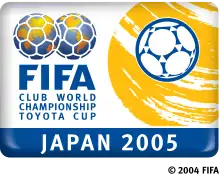 FIFA CWCTC 2005 official logo | |
| Tournament details | |
| Host country | Japan |
| Dates | 11 – 18 December |
| Teams | 6 (from 6 confederations) |
| Venue(s) | 3 (in 3 host cities) |
| Final positions | |
| Champions | |
| Runners-up | |
| Third place | |
| Fourth place | |
| Tournament statistics | |
| Matches played | 7 |
| Goals scored | 19 (2.71 per match) |
| Attendance | 261,456 (37,351 per match) |
| Top scorer(s) | (2 goals each) |
| Best player(s) | |
| Fair play award | |
The football tournament was held in Japan from 11 to 18 December 2005 and won by Brazilian club São Paulo, who defeated English side Liverpool 1–0 in the final.
Background
The 2005 tournament was created as a merger between the Intercontinental Cup and the earlier FIFA Club World Championships. The previous of these had been running as an annual tournament between the champions of Europe and South America since 1960; the latter had undergone just one tournament, the 2000 FIFA Club World Championship. The 2001 tournament had been cancelled when FIFA's marketing partner ISL went bankrupt. To celebrate the marriage between the two competitions, a new trophy was introduced by FIFA.
As a result of this merger, the tournament was conceived as being smaller than the original Club World Championship, which had lasted two weeks, yet building on the one game format of the Intercontinental Cup. Six clubs were invited to take part in the tournament, one representing each regional football confederation. The competition's name, which was the simple union between the name of the two previous merging competitions, was evidently too long, and was going to be reduced the following year, becoming the FIFA Club World Cup.
Format
The competition was a knockout tournament so each team played two or three matches. The champions of the four "weaker" confederations played in the quarter-finals; the losers played in a fifth place play-off. The winners were then joined by the European and South American champions in the semi-finals; the losers played in a third place play-off.
The matches were held in Tokyo's National (Olympic) Stadium, Toyota Stadium in Toyota, Aichi, near Nagoya and the International Stadium in Yokohama, where the final was played. For marketing purposes it was known as the FIFA Club World Championship Toyota Cup.
Qualified teams
The following teams qualified during 2005:
| Team | Confederation | Qualification |
|---|---|---|
| Enter in the semi-finals | ||
| UEFA | 2004–05 UEFA Champions League winners | |
| CONMEBOL | 2005 Copa Libertadores winners | |
| Enter in the quarter-finals | ||
| CAF | 2005 CAF Champions League winners | |
| AFC | 2005 AFC Champions League winners | |
| CONCACAF | 2005 CONCACAF Champions' Cup winners | |
| OFC | 2004–05 Oceania Club Championship winners | |
Venues
Tokyo, Yokohama and Toyota were the three cities to serve as venues for the 2005 FIFA Club World Cup.
| Yokohama | Tokyo | Toyota | ||
|---|---|---|---|---|
| International Stadium Yokohama | National Stadium | Toyota Stadium | ||
| 35°30′36.16″N 139°36′22.49″E | 35°40′41.00″N 139°42′53.00″E | 35°05′04.02″N 137°10′14.02″E | ||
| Capacity: 72,327 | Capacity: 57,363 | Capacity: 45,000 | ||
 |
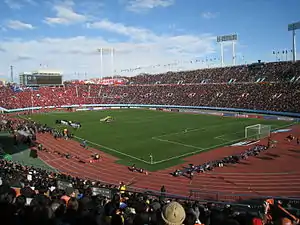 |
 | ||
Squads
Match officials
| Confederation | Referee | Assistant referees |
|---|---|---|
| AFC | ||
| CAF | ||
| CONCACAF | ||
| CONMEBOL | ||
| UEFA | ||
Bracket
| Quarter-finals | Semi-finals | Final | ||||||||||||
| 11 December – Tokyo | ||||||||||||||
| |
1 | |||||||||||||
| 14 December – Tokyo | ||||||||||||||
| |
0 | |||||||||||||
| |
2 | |||||||||||||
| Fifth place | ||||||||||||||
| |
3 | |||||||||||||
| |
1 | |||||||||||||
| 18 December – Yokohama | ||||||||||||||
| |
2 | |||||||||||||
| |
1 | |||||||||||||
| 16 December – Tokyo | 12 December – Toyota City | |||||||||||||
| |
0 | |||||||||||||
| |
0 | |||||||||||||
| 15 December – Yokohama | ||||||||||||||
| |
1 | |||||||||||||
| |
0 | |||||||||||||
| Third place | ||||||||||||||
| |
3 | |||||||||||||
| |
2 | |||||||||||||
| |
3 | |||||||||||||
| 18 December – Yokohama | ||||||||||||||
Matches
Semi-finals
| Al-Ittihad | 2–3 | |
|---|---|---|
| Noor Al-Montashari |
Report | Amoroso Rogério Ceni |
Third place play-off
Scorers
There were 19 goals scored in 7 matches, for an average of 2.71 goals per match.
2 goals
 Amoroso (São Paulo)
Amoroso (São Paulo) Peter Crouch (Liverpool)
Peter Crouch (Liverpool)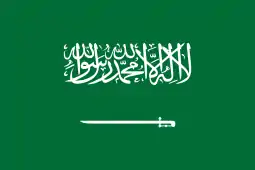 Mohammed Noor (Al-Ittihad)
Mohammed Noor (Al-Ittihad) Álvaro Saborío (Saprissa)
Álvaro Saborío (Saprissa)
1 goal
 Hamad Al-Montashari (Al-Ittihad)
Hamad Al-Montashari (Al-Ittihad) Christian Bolaños (Saprissa)
Christian Bolaños (Saprissa).svg.png.webp) David Carney (Sydney FC)
David Carney (Sydney FC) Steven Gerrard (Liverpool)
Steven Gerrard (Liverpool) Rónald Gómez (Saprissa)
Rónald Gómez (Saprissa) Joseph-Désiré Job (Al-Ittihad)
Joseph-Désiré Job (Al-Ittihad)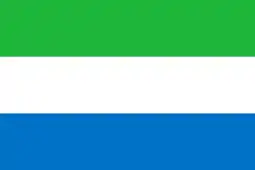 Mohammed Kallon (Al-Ittihad)
Mohammed Kallon (Al-Ittihad) Mineiro (São Paulo)
Mineiro (São Paulo)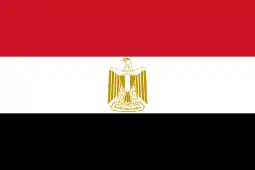 Emad Moteab (Al-Ahly)
Emad Moteab (Al-Ahly) Rogério Ceni (São Paulo)
Rogério Ceni (São Paulo)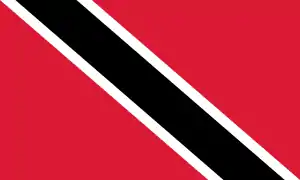 Dwight Yorke (Sydney FC)
Dwight Yorke (Sydney FC)
Awards
| Golden Ball | Silver Ball | Bronze Ball |
|---|---|---|
(São Paulo) |
(Liverpool) |
(Saprissa) |
| Player of the Final | ||
| Fair play | ||
Tournament round-up
Final standings
| Pos | Team | Confederation | Pld | W | D | L | GF | GA | GD |
|---|---|---|---|---|---|---|---|---|---|
| 1 | CONMEBOL | 2 | 2 | 0 | 0 | 4 | 2 | +2 | |
| 2 | UEFA | 2 | 1 | 0 | 1 | 3 | 1 | +2 | |
| 3 | CONCACAF | 3 | 2 | 0 | 1 | 4 | 5 | −1 | |
| 4 | AFC | 3 | 1 | 0 | 2 | 5 | 6 | −1 | |
| 5 | OFC | 2 | 1 | 0 | 1 | 2 | 2 | 0 | |
| 6 | CAF | 2 | 0 | 0 | 2 | 1 | 3 | −2 |
Views on the tournament
The tournament was quite well received, although some commentators have stated that, excluding São Paulo and Liverpool, the quality of football was quite poor leading to a view that it might have been better retaining the two continent format of the European/South American Cup.[1]
.svg.png.webp)

